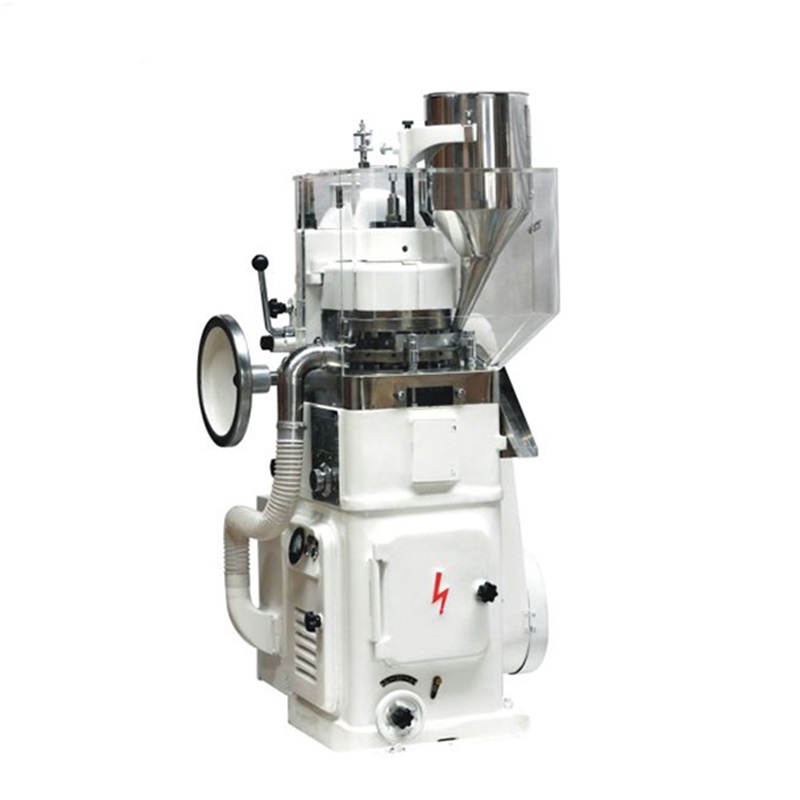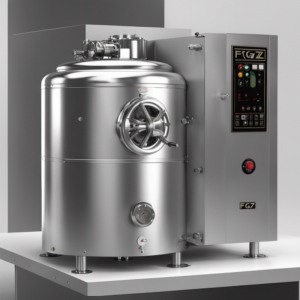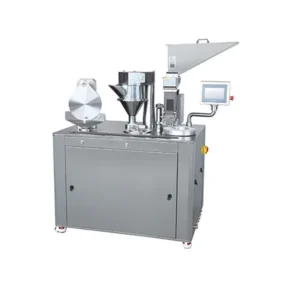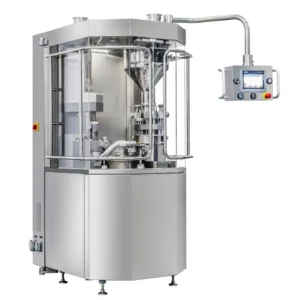Description
| Parameter | Specification |
|---|---|
| Model | ZP17/19 |
| Number of Stations | 17 or 19 |
| Maximum Output | Up to 180,000 tablets/hour |
| Maximum Tablet Diameter | 25mm |
| Maximum Filling Depth | 20mm |
| Maximum Pressure | 80kN |
| Main Motor Power | 5.5 kW |
| Overall Dimensions (LxWxH) | 1100mm x 900mm x 1600mm |
| Weight | Approximately 2000 kg |
| Power Supply | 380V, 50Hz (can be customized) |
| Compressed Air Supply | 0.1m³/min at 0.4-0.6 MPa |
A rotary tablet press is used to compress powder formulations into tablets that have uniform sizes, shapes, and weights. This involves using dies and punches pushing the powder to form the desired tablet shape. Rotary tablet presses are widely used in the pharmaceutical, nutraceutical, and chemical industries for mass production of tablets.
THE ZP17/19 ROTARY TABLET PRESS
The ZP17/19 Rotary Tablet Press is a highly modern pharmaceutical machine that has been manufactured to ensure enhanced quality standards as well as efficiency. Being developed by leading engineering firms that deal with pharmaceutical equipment, this rotary tablet press combines advanced technology and strong construction to give excellent performance.
Main Features
High-Speed Production: Its ability to produce at very high speeds makes it perfect for large-scale productions.
Precision Control: This ensures accurate dosing and compression through advanced control systems hence maintaining consistent quality tablets throughout its operations.
Flexibility: These include tooling options that allow the production of various types of tablets based on their size and shape.
Ease of Maintenance: It is designed in a way that maintenance is easy as well as cleaning therefore minimizing downtime thus ensuring an undisrupted production process.
GMP Compliance: Assembled according to the Good Manufacturing Practices (GMP) which makes it suitable for use in pharmaceutical manufacturing, the press meets all regulatory requirements within this sector.
Working Principle
To produce good-quality tablets; several steps take place during the operation or working process of the ZP17/19 Rotary Tablet Press Machine;
1. Feeding
Firstly during the process, a powdered formulation is fed into a hopper located at one end of the tablet press. The powder can be either pre-mixed or directly fed from a granulation or mixing unit.
2. Compression
Next, starting from an approach zone where powders enter, they are compressed between punches and die to form tablets. The compression force may also be adjusted depending on formulation needs.
3. Ejection
After the compression, the tablets are removed from the die and collected either on a conveyor belt or in another container for further processing or packaging.
4. Tablet Inspection
Tablets can be inspected for defects such as chips, caps, or improper weights to ensure only quality ones are packed for distribution.
Applications
Besides being commonly used in pharmaceutical manufacturing industries, there are several other uses of The ZP17/19 Rotary Tablet Press;
Pharmaceuticals: Tablets prepared for oral administration including prescription drugs, over-the-counter medications, and vitamins.
Nutraceuticals: Supplements and herbal formulations are made into solid dosage forms as tablets by this machine.
Chemicals: It is also used for compressing chemical powders into industrial and agricultural tablets.
Functions
The ZP17/19 Rotary Tablet Press has various functions that it performs during the production of tablets;
Powder Compaction: Powders get pressed into uniformly sized and weighted tablets.
Tablet Formation: The shape of compressed powder becomes what we call a tablet – round or oval shapes among other custom designs.
Dosing Control: It ensures consistent dosing of powdered formulation throughout all its products to maintain uniformity among them
Compression Force Adjustment: The compression force can be adjusted so that it can suit different tablet characteristics and formulations.
Tablet Ejection: At times, formed tablets will need to be automatically ejected from dies before their collection for further processing takes place thereafter.
Future Trends
Thus, modernizing this technology like that found in rotary presses such as the ZP17/19 model is expected to increase their efficiency, flexibility, and quality control. Some of the likely trends include;
Integration of IoT: This could enable real-time monitoring of machine performance as well as predictive maintenance coupled with quality assurance using Internet of Things (IoT) technology
Automation and Robotics: For more efficiency and decreased labor, there will be increased integration of automation and robotics.
Advanced Control Systems: There is use of artificial intelligence and machine learning algorithms in implementing advanced control systems that can optimize process control as well as quality management.
Continuous Manufacturing: By adopting continuous manufacturing techniques, productivity is enhanced while production time is reduced.
Customization and Personalization: The rotary tablet presses are designed in such a way that they can make tablets specific to certain patients or produce personalized medication.
Roles and Advantages
Among other things, the ZP17/19 Rotary Tablet Press plays a significant role in pharmaceutical manufacturing with several benefits accruing to both manufacturers and consumers.
Roles
Mass Production: It facilitates fast production of tablets which are common among major pharmaceutical manufacturers worldwide.
Quality Assurance: The system guarantees the manufacture of absolutely uniform drug products that meet all regulatory requirements imposed on the healthcare industry vis-a-vis safety or efficacy standards.
Flexibility: They enable the production of a wide variety of tablet shapes, dosage forms, and sizes for different markets across the globe.
Cost-Effective Production: It improves manufacturing operations by making them less costly to run while enhancing their efficiency levels simultaneously.
Advantages
Increased Productivity: Increased productivity arises from high-speed operations made possible by the ZP17/19 Rotary Tablet Press hence achieving the manufacturer’s production targets effectively.
Consistent Quality: This guarantees each one meets stringent quality standards through employing sophisticated means like advanced control systems or even precision engineering thus minimizing their variability as well as defects during the entire life cycle of the product itself including its usage once consumed by patients/consumers/users/patients (as may be said).
Reduced Downtime: The press is easy to clean, and maintain and has been designed to minimize breakdowns thereby reducing downtime during the operation period ensuring continuity of workflow throughout its useful life span till obsolescence occurs due to technological change within an industry where it operates under different environments than any other competing company.
Regulatory Compliance: Being GMP compliant, the ZP17/19 Rotary Tablet Press is manufactured in adherence to GMP guidelines which are by pharmaceutical manufacturing regulations thus ensuring that pharmaceutical products meet their desired requirements related to safety or efficacy.
Enhanced Market Competitiveness: The press enhances the competitiveness of global pharmaceutical manufacturers by offering efficient production capabilities and consistent product quality.
Most Commonly Asked Questions
1. What is a ZP17/19 Rotary Tablet Press?
ZP17/19 is a highly complex pharmaceutical equipment designed to convert powder mixtures into tablets that have uniform weight, shape, and size. It utilizes advanced technology and precision engineering to cater to high-speed tablet production needs.
2. What are the key features of the ZP17/19 Rotary Tablet Press?
Important features include high-speed production capability, precision control systems, flexibility in tooling options, ease of maintenance, and Good Manufacturing Practices (GMP) compliance requirements.
3. How does the ZP17/19 Rotary Tablet Press work?
Within the compression region where punches apply pressure to powder formulations compressing them into tablets, ZP17/19 introduces powder formulations through feeding channels followed by ejection systems for compressed tablets from dies after which these tablets can then undergo further processing such as packaging, etc.
4. What are the applications of the ZP17/19 Rotary Tablet Press?
The machine is used primarily for producing tablets meant for oral administration in medicine with other industries including nutraceuticals and chemicals moldsinvolved in dietary supplement formulation as well as making industrial chemicals just some examples among many others.
5. How does the ZP17/19 ensure quality control during tablet production?
This ensures accurate dosing through using advanced control systems that enable precise adjustment of compression forces as well as ejectors expelling tablets off their respective moulds after pressing therefore resulting in uniformity that meets all regulatory expectations concerning safety or efficacy standards applicable throughout the life cycle of the drug product starting from when it is used by patients (as might be stated).
6. What are the advantages of using the ZP17/19 Rotary Tablet Press?
These may include increased productivity due to high-speed production, assurance of consistent quality in products, availability of longer operation time since maintenance procedures can be completed quickly and easily, ability to meet regulatory requirements for pharmaceutical manufacturing as well as better competition strategy among other things.
7. Can the ZP17/19 Rotary Tablet Press accommodate different tablet shapes and sizes?
Yes, tablet production using the ZP17/19 has been improved due to its flexibility to take up different tooling options, resulting in a variety of shapes and sizes that can be suited for different markets.
8. What are some emerging trends associated with rotary tablet press technology such as the ZP17/19?
Some coming trends include the use of IoT technology for real-time monitoring and predictive maintenance, more automation and robotics integration, application of advanced control systems employing artificial intelligence, adoption of continuous manufacturing methods, and customization for personalized medicines.
9. Can The ZP17/19 Rotary Tablet Press Be Used For Small-Scale Production?
This is because the ZP17/19 can work at higher speeds but it can also be employed in small-scale production which means it is flexible to both large and small-scale manufacturers.
10. How do I ensure optimal performance of the zp17/19 rotary tablet press machine?
This includes regular maintenance, adherence to the manufacturer’s operating guidelines, proper calibration of control systems, and training personnel involved in operating this machine.





Reviews
There are no reviews yet.